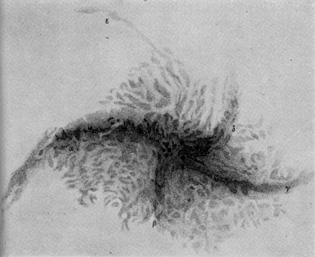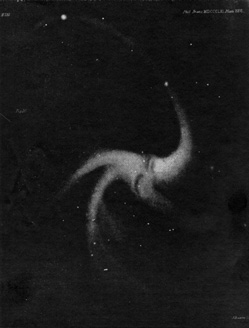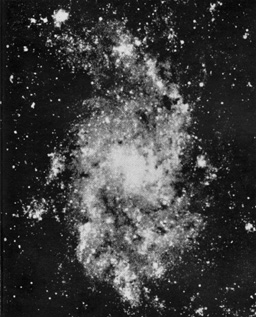


The idea that our Sun is just one of myriads of stars in a huge stellar system, the Milky Way, and that there may be many other stellar systems of equal rank outside the Milky Way can be traced back to the early eighteenth century (1). These early speculations (1) by the Swedish philosopher, Emanuel Swedenborg (2) had no basis in actual observations. Yet they are remarkably close to the present-day views of the cosmos. Thomas Wright of Durham in England, writing at the middle of the same century (3), conceived the idea apparently independently and was the first to appeal to observational evidence in support of it (2). The best-known of the early exponents of the 'island universe' theory are the German philosopher Immanuel Kant (4), who acknowledged his indebtedness to the ideas of Wright, and the English astronomer, Sir William Herschel, who was the first to bring observational techniques to bear specifically on the study of nebulae and clusters of stars. In contrast, Messier compiled his catalogue of nebulae and clusters, which predates Herschel's work, primarily as a list of 'nuisances' to be avoided in his search for new comets (5).
At first it was not possible observationally to distinguish between gaseous nebulae and stellar aggregations, and it was thought that all nebulae were groups of stars - some of them so distant that individual stars could not be resolved. Since Herschel (6) was prepared to allow a wide range of nebular sizes, from those comprising only a few stars to systems of equal rank to the Milky Way (among which he included M33, as well as M17, M31, and Orion), he attempted to estimate the distances to nebulae on the basis of the amount of incipient resolution into stars. Then he found (7) the planetary nebula NGC 1514 which, from its appearance (8), was obviously a single star associated with faint nebulosity, a 'nebulous star'. For this reason, and from the fact that star counts in selected regions ('gauges') did not enable him to penetrate to the outside of the Milky Way, Herschel totally revised his thinking, now maintaining (9) that all nebulae were small compared to the Milky Way and were encompassed within it. The controversy between the two views was not to be resolved for more than a century after his death in 1822.
The observations by the Earl of Rosse with his 72-inch reflector raised the fortunes of the island-universe theory again. In 1845 he found the spiral nature of M51. His paper in 1850 (10) contained drawings of five spiral nebulae, including M33 (see Plate I), and listed fourteen more (3). He also remarked that some of these spirals could be resolved into stars (4). On this basis, and using the star counts made by the Herschels, Alexander (12) suggested 'that the Milky Way and the stars within it together constitute a spiral with several (it may be four) branches', and traced the branches across the sky. But, in his essay on the nebular hypothesis (13), Herbert Spencer argued that since all stars are of similar sizes, all nebulae should be of similar sizes; and if the nebulae are actually stellar aggregations, then the apparently largest and presumably closest should be resolvable while the smallest and farthest should remain unresolved. In arguing that many quite small nebulae could in fact be resolved, Spencer mistook small clusters for nebulae. However, this was not immediately recognized.

|
Plate 1. Plate XXXVI. Fig. 5, H. 131 - This figure represents the central portion of a very large nebula. The nebula itself has not been sufficiently examined, but as yet no other portion appears to have a spiral, or indeed any regular arrangement. The sketch is not very accurate, but represents sufficiently well the general character of the central portion. 'September 6, 1849 - A spiral.
'September 16, 1849 - New spiral;
'September 10, 1849 - An attempt at a drawing taken: fog. 'October 1849 - The whole nebula in flocculi.' The Earl of Rosse's drawing and description of Messier 33 (10). |

|
Plate IIa. Drawing and photograph of Messier 33. The drawing shows how M33 appeared to the Earl of Rosse through his 72-inch reflecting telescope (11). |

|
Plate IIb. The photograph, reproduced to the same scale as the drawing, was obtained with the Mt Palomar 48-inch Schmidt telescope on an emulsion sensitive to red light. |
In 1864, Sir William Huggins (14) observed several nebulae with a spectroscope, finding first an emission-line spectrum for the planetary nebula NGC 6543 and, a few nights later, a continuous spectrum with a hint of absorption features for the great Andromeda nebula. This showed that nebulae could be divided into two fundamentally distinct classes: those that were clouds of luminous gas and those that were stellar aggregations. All of the spiral nebulae were found to belong to the latter class. The conclusive evidence of this was presented in 1899 by Schemer (15) in the form of the first good-quality spectrogram of a spiral nebula, M31.
The application of photography to studies of nebulae at the turn of the century made it possible to get more detailed pictures of the form of the spiral nebulae. The pioneering work in this field was done by the Irish amateur astronomer Isaac Roberts (16a, b) and by J.E. Keeler with the 36-inch Crossley reflector of the Lick Observatory (17). On the basis of these photographs, the spiral nebulae were subclassified into a 'condensed' type, showing condensations or knots of incipient resolution over the entire face of the nebula, and an 'uncondensed' type, showing incipient resolution only in the outermost parts of the nebula, if at all. The prototypes of the two groups were M33 and M31, respectively. Dreyer (18), using photographs taken by Roberts, published a catalogue of the condensations in M33 with the intent that it form a basis for determining whether there were any changes in the nebula in the course of time. Von der Pahlen (19) attempted to fit the forms of the arms of spirals to mathematical curves. He found that the two main arms of M33 fit logarithmic spirals quite well, but that they had different rates of coiling and that they were not 180° apart. Wolf and Ernst (20a, b) catalogued 517 knots of nebulosity in a region centred on M33, extending over a diameter of several degrees but omitting the portion within 25' of its nucleus. They found that the nebulae tended to concentrate in patterns which looked like extensions of the spiral arms so prominent in the inner part of M33. They claimed that the spiral pattern could be followed over a region 8° in diameter and concluded that M33 must therefore be quite nearby.
In 1914, Slipher (21) reported a radial velocity of -300 km s-1 for M31, and Wolf (22) reported the first spectrographic measurements of internal motions of spirals, finding rotational velocities of 100 km s-1 in M81. In a larger-scale survey of the motions of spirals, Slipher (23) noted that their average velocity was roughly 25 times as large as the average stellar velocity, larger than for any other class of astronomical objects. He also found large internal motions, evidenced by a rotational velocity of the edge-on spiral NGC 4594 of 100 km s-1 20" from the nucleus. Pease (24), (25) confirmed the finding of large internal motions in spirals by measuring a difference of roughly 200 km s-1 between the radial velocities of the nucleus of M33 and of NGC 604, a bright condensation 10' from the nucleus. The large systemic radial velocities indicated that the spirals could not be gravitationally bound by the Milky Way, and were thus at least not permanent members of it. The radial-velocity measurements of internal motions, if they could be combined with proper-motion data, would provide a direct measurement of the distances of the spirals.
During the first few years the Mt Wilson 6o-inch telescope was in operation, Ritchey had obtained the best nebular photographs yet. His pictures of the condensed type of spirals showed many points in the nebulae which could be measured for proper motion. Second epoch plates were taken and measured by van Maanen. In 1916 he reported (26) finding motions in M101 which could be interpreted either as rotation or as outward streaming along the spiral arms. In either case, the fact that proper motions could be measured in the spirals indicated that they were nearby objects. His paper on M33 (27) contains a summary of his measurements and interpretations. To provide a check on these critical measurements, Lundmark independently remeasured the more than 400 points on van Maanen's plates of M33. Although his results correlated well with van Maanen's with respect to both direction and relative size of proper motion, the absolute scale of Lundmark's proper motions was less than 1/10 as large as those van Maanen had measured (28).
Meanwhile, evidence supporting the extragalactic interpretation of spiral nebulae began to mount up. In 1917, Ritchey's first photographic discovery of a nova in a spiral nebula (29), spurred Ritchey (30) and Curtis (31) to examine the large plate collections of Mt Wilson and Lick Observatories, where they found a score of others that had gone undetected in previous years, including two in M31. Systematic surveys over the next two years produced 14 additional novae in M31, but none in any other spiral. These formed a homogeneous group, all peaking at about mpg = 17, about 10 magnitudes fainter than the visually detected nova S Andromedae of 1885 in M31. S And, on the other hand, was the only nova in M31 which conformed to the pattern of the novae discovered in other spirals, all of which had light outputs which were appreciable fractions of the total light outputs of the associated nebulae. At this time there was no compelling reason to choose either type of nova to represent the analogue of the galactic novae.
In 1921, Lundmark (32) found that counts of stars brighter than mpg = 15.7 in the field of M33 were not influenced by its presence. Hence M33 had to be farther away than the average 15.7m star, roughly 3 kpc. Moreover, if the brightest stars in M33 had absolute magnitudes of -6, it had to be 300 kpc away. In 1922, Duncan (33) discovered three recurrent variable stars in M33, the first found in any spiral. He also reported a suspected nova. By the end of 1924, Hubble (34) had assembled data on 47 variables in M33, 22 of which were Cepheids obeying the same period-colour-index and period-amplitude relations as the Cepheids in the Milky Way and the Magellanic Clouds. Applying the period-luminosity law, Hubble derived a distance of 285 kpc to M33, and a comparable result from similar data for M31. These distances agreed with those derived from the brightest non-variable stars and with those derived by choosing to identify the fainter of the two types of novae in M31 with galactic novae; S And and the novae in the other spirals were called supernovae. Star counts in M33 (35), coupled with the Cepheid distance scale, showed that its luminosity function agreed with Kapteyn's luminosity function for the Milky Way, and thus appeared to settle the island-universe controversy. The one remaining loose end was the question of the reality of van Maanen's rotations. This was decided negatively on the basis of plates of M33 and M74 from the Mt Wilson 100-inch telescope (36a, b, c).
1 Swedenborg wrote in the first chapter of the third part of his Principia:
'The common axis of the sphere or starry heaven seems to be the galaxy, where we perceive the greatest number of stars.... There may be innumerable spheres of this kind or starry heavens in the finite universe. These may be associated one with the other... and the whole visible starry heaven is perhaps but a point in respect to the universe. The objects comprehended within the range of our bodily vision are perhaps few; the greater number can be comprehended only by the mind. This very starry heaven, stupendous as it is, forms, perhaps, but a single sphere, of which our solar vortex constitutes only a part; for the universe is finited in the infinite. Possibly there may be other spheres without number similar to those we behold; so many indeed and so mighty, perhaps, that our own may be respectively only a point; for all the heavens, however many, however vast, yet being but finite, and consequently having their bounds, do not amount even to a point in comparison with the infinite.'
An interesting sidelight is cast by this excerpt from the following chapter, which foreshadows the idea of continuous creation contained in the hypothesis of the steady-state universe:
'Nor can she [nature] relatively equal or occupy a point of the infinite. Hence new heavens one after the other may arise; in these heavens, new vortices and world-systems; in these world-systems, new planets; around the planets, new satellites; and in this manner, at the will of the Deity, new creations may arise in endless succession.' Back.
2 'That this in all Probability may be the real Case, is in some Degree made evident by the many cloudy Spots, just perceivable by us, as far without our starry Regions, in which tho' visibly luminous Spaces, no one Star or particular constituent Body can possibly be distinguished; those in all likelihood may be external Creation, bordering upon the known one, too remote for even our Telescopes to reach.' Back.
3 Rosse's second paper (11) contains a drawing of M33 in which the spiral pattern is delineated over a region ~ 20' in diameter, in good agreement with the most prominent arms seen on modern photographs. See Plate IIa and IIb. Back.
4 While it is conceivable that Rosse could have resolved the brightest individual stars in M33, in the more distant spirals (and probably also in M33) what he thought were stars must have been compact clusters or associations. Back.